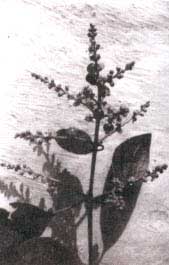Mr. P.G. Jayachandran of Thrissur district in Kerala in his farm. Generating a better income from a limited area is an art, especially in farming operations, where judicious use of available space is an important factor. Very fewfarmers who practise integrated farming succeed in generating a good income from it. Managing successfully Mr. P.G. Jayachandran of Thrissur district in Kerala seems to be case in point. He has been successfully able to manage both crops and animal husbandry in his seven acre farm and integrate the different components into a single unit. He has a dairy unit of nine cows, with a daily milk production of about 60 litres. A part of the milk is sold to a milk society and the rest is used for making value added products such as buttermilk and ghee. Organic manures Fodder grass for the cattle is raised as an intercrop in his farm and coconut oil cake is used as feed for the animals. Organic manures such as cattle manure are the main source of nutrients for his crops. He also has a collection of Malabari, Jamnapari and Sannan goat breeds which are mainly used for kid production. A piggery unit comprising large White Yorkshire and Landrace breeds, is primarily used for utilisation of agricultural waste. The piggery unit provides him considerable income without much expenditure, according to Dr. Sabin George, Assistant Professor (Animal Husbandry), Krishi Vigyan Kendra (KVK), Thrissur. Back yard poultry with about 50 layer birds of Gramalakshmi and Rhode Island Red breeds yield about 40 eggs daily which are sold in the market. In addition, he also has turkey, quail and guinea fowl. Good demand He has about 200 coconut palms, yielding 150 nuts a year, a part of which is used for seed nut production for his own nursery. The remaining nuts are used for production of coconut oil which has a good demand at his farm itself. He earns aboutRs. 1lakh a year from coconuts alone, after meeting all the expenses. According to Dr. T.N. Jagadeesh Kumar, Associate Professor, KVK, Thrissur, the different enterprises in his farm are arranged systematically to encourage maximum utilization of land and resources and integration of various components. Plantation crops such as rubber, coconut, and arecanut occupy the prime area of the farm. Other crops such as vegetables, banana, pepper, cocoa, colocasia, elephant foot yam, and yams are intercropped, wherever feasible. The animal sheds are situated at the middle to facilitate transport of manures to all parts of the farm. Water harvesting Water harvesting devices (tanks lined with silpauline sheets) are located at an elevation which permits gravitational flow of water to all parts of the farm. Fish varieties such as Rohu, Catla, Grass carp and Mrigal are bred in a twenty-five cent pond in the farm, and the slurry used for irrigation. In addition, Mr. Jayachandran maintains a biogas plant and vermicompost unit for organic manure production. He raises azolla in shallow tanks for feeding poultry and cattle, which improve the quality of produce. Intercropping The coconut and arecanut gardens are intercropped with banana, colocasia and yams. He has a wide collection - about 15 types of banana. He considers banana as a maximum utility crop since all the plant parts are used - bunches harvested, suckers sold and the pseudostem used for mulching and vermicompost production. Banana cultivation, mostly intercropped, alone gives him an annual return of Rs.85,000. The farmer also has about 50 nutmeg trees, intercropped with garcinia, and coffee. Part of the garcinia and coffee is used for home consumption and the balance, marketed. He maintains a nursery in his farm where good quality seedlings of all the crop varieties grown and sold. Readers can contact Mr. P. G. Jayachandran, Puthuppally House, Kaniarkode Post, Pin 680 659 Thiruvilwamala Via, Thrissur 680 594 and Dr. T N. Jagadeesh Kumar, Associate Professor (Agronomy), mobile: 9447467288 and Dr. Sabin George, Assistant Professor (Animal Husbandry), K.V.K, Thrissur, Vellanikkara, KAU Post, pin 680 656, mobile: 9446203839.










